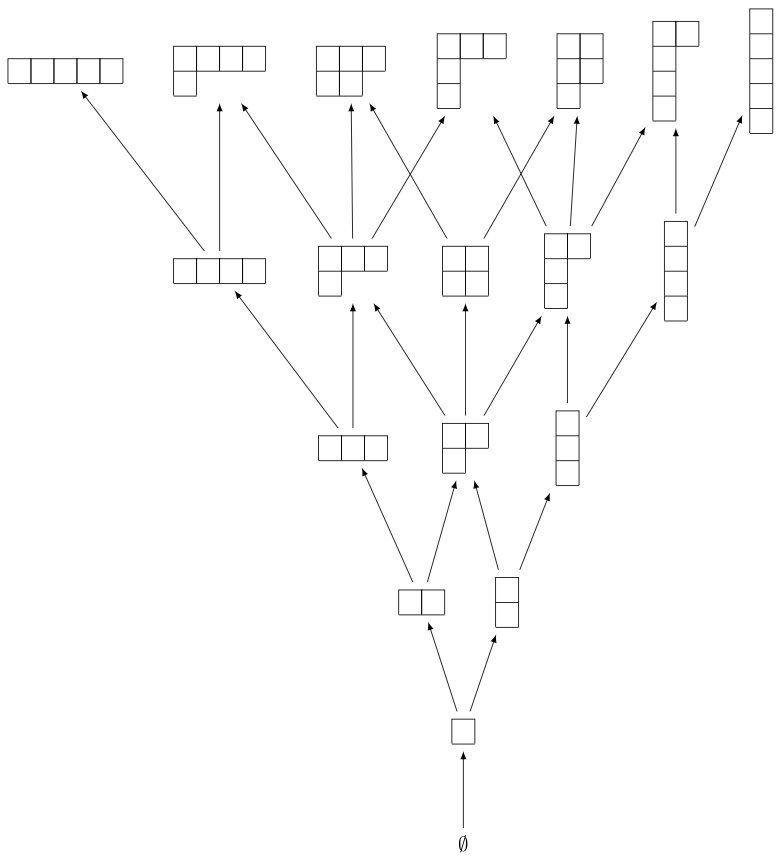Young’s lattice and the RSK algorithm¶
This section provides some examples on Young’s lattice and the RSK (Robinson-Schensted-Knuth) algorithm explained in Chapter 8 of Stanley’s book [Stanley2013].
Young’s Lattice¶
We begin by creating the first few levels of Young’s lattice
sage: level = 6
sage: elements = [b for n in range(level) for b in Partitions(n)]
sage: ord = lambda x,y: y.contains(x)
sage: Y = Poset((elements,ord), facade=True)
sage: H = Y.hasse_diagram()
>>> from sage.all import *
>>> level = Integer(6)
>>> elements = [b for n in range(level) for b in Partitions(n)]
>>> ord = lambda x,y: y.contains(x)
>>> Y = Poset((elements,ord), facade=True)
>>> H = Y.hasse_diagram()
level = 6 elements = [b for n in range(level) for b in Partitions(n)] ord = lambda x,y: y.contains(x) Y = Poset((elements,ord), facade=True) H = Y.hasse_diagram()
The resulting image looks best when dot2tex is installed:
sage: view(H) # not tested
>>> from sage.all import *
>>> view(H) # not tested
view(H) # not tested

We can now define the up and down operators
sage: QQY = CombinatorialFreeModule(QQ,elements)
sage: def U_on_basis(la):
....: covers = Y.upper_covers(la)
....: return QQY.sum_of_monomials(covers)
sage: def D_on_basis(la):
....: covers = Y.lower_covers(la)
....: return QQY.sum_of_monomials(covers)
>>> from sage.all import *
>>> QQY = CombinatorialFreeModule(QQ,elements)
>>> def U_on_basis(la):
... covers = Y.upper_covers(la)
... return QQY.sum_of_monomials(covers)
>>> def D_on_basis(la):
... covers = Y.lower_covers(la)
... return QQY.sum_of_monomials(covers)
QQY = CombinatorialFreeModule(QQ,elements)
def U_on_basis(la):
covers = Y.upper_covers(la)
return QQY.sum_of_monomials(covers)
def D_on_basis(la):
covers = Y.lower_covers(la)
return QQY.sum_of_monomials(covers)
As a shorthand, one also can write the above as:
sage: U_on_basis = QQY.sum_of_monomials * Y.upper_covers
sage: D_on_basis = QQY.sum_of_monomials * Y.lower_covers
>>> from sage.all import *
>>> U_on_basis = QQY.sum_of_monomials * Y.upper_covers
>>> D_on_basis = QQY.sum_of_monomials * Y.lower_covers
U_on_basis = QQY.sum_of_monomials * Y.upper_covers D_on_basis = QQY.sum_of_monomials * Y.lower_covers
Here is the result when we apply the operators to the partition
sage: la = Partition([2,1])
sage: U_on_basis(la)
B[[2, 1, 1]] + B[[2, 2]] + B[[3, 1]]
sage: D_on_basis(la)
B[[1, 1]] + B[[2]]
>>> from sage.all import *
>>> la = Partition([Integer(2),Integer(1)])
>>> U_on_basis(la)
B[[2, 1, 1]] + B[[2, 2]] + B[[3, 1]]
>>> D_on_basis(la)
B[[1, 1]] + B[[2]]
la = Partition([2,1]) U_on_basis(la) D_on_basis(la)
Now we define the up and down operator on
sage: U = QQY.module_morphism(U_on_basis)
sage: D = QQY.module_morphism(D_on_basis)
>>> from sage.all import *
>>> U = QQY.module_morphism(U_on_basis)
>>> D = QQY.module_morphism(D_on_basis)
U = QQY.module_morphism(U_on_basis) D = QQY.module_morphism(D_on_basis)
We can check the identity
sage: for p in Partitions(3):
....: b = QQY(p)
....: assert D(U(b)) - U(D(b)) == b
>>> from sage.all import *
>>> for p in Partitions(Integer(3)):
... b = QQY(p)
... assert D(U(b)) - U(D(b)) == b
for p in Partitions(3):
b = QQY(p)
assert D(U(b)) - U(D(b)) == b
We can also check that the coefficient of
sage: u = QQY(Partition([]))
sage: for i in range(4):
....: u = U(u)
sage: u
B[[1, 1, 1, 1]] + 3*B[[2, 1, 1]] + 2*B[[2, 2]] + 3*B[[3, 1]] + B[[4]]
>>> from sage.all import *
>>> u = QQY(Partition([]))
>>> for i in range(Integer(4)):
... u = U(u)
>>> u
B[[1, 1, 1, 1]] + 3*B[[2, 1, 1]] + 2*B[[2, 2]] + 3*B[[3, 1]] + B[[4]]
u = QQY(Partition([]))
for i in range(4):
u = U(u)
u
For example, the number of standard Young tableaux of shape
sage: StandardTableaux([2,1,1]).cardinality()
3
>>> from sage.all import *
>>> StandardTableaux([Integer(2),Integer(1),Integer(1)]).cardinality()
3
StandardTableaux([2,1,1]).cardinality()
We can test this in general:
sage: for la in u.support():
....: assert u[la] == StandardTableaux(la).cardinality()
>>> from sage.all import *
>>> for la in u.support():
... assert u[la] == StandardTableaux(la).cardinality()
for la in u.support():
assert u[la] == StandardTableaux(la).cardinality()
We can also check this against the hook length formula (Theorem 8.1):
sage: def hook_length_formula(p):
....: n = p.size()
....: return factorial(n) // prod(p.hook_length(*c) for c in p.cells())
sage: for la in u.support():
....: assert u[la] == hook_length_formula(la)
>>> from sage.all import *
>>> def hook_length_formula(p):
... n = p.size()
... return factorial(n) // prod(p.hook_length(*c) for c in p.cells())
>>> for la in u.support():
... assert u[la] == hook_length_formula(la)
def hook_length_formula(p):
n = p.size()
return factorial(n) // prod(p.hook_length(*c) for c in p.cells())
for la in u.support():
assert u[la] == hook_length_formula(la)
RSK Algorithm¶
Let us now turn to the RSK algorithm. We can verify Example 8.12 as follows:
sage: p = Permutation([4,2,7,3,6,1,5])
sage: RSK(p)
[[[1, 3, 5], [2, 6], [4, 7]], [[1, 3, 5], [2, 4], [6, 7]]]
>>> from sage.all import *
>>> p = Permutation([Integer(4),Integer(2),Integer(7),Integer(3),Integer(6),Integer(1),Integer(5)])
>>> RSK(p)
[[[1, 3, 5], [2, 6], [4, 7]], [[1, 3, 5], [2, 4], [6, 7]]]
p = Permutation([4,2,7,3,6,1,5]) RSK(p)
The tableaux can also be displayed as tableaux:
sage: P,Q = RSK(p)
sage: P.pp()
1 3 5
2 6
4 7
sage: Q.pp()
1 3 5
2 4
6 7
>>> from sage.all import *
>>> P,Q = RSK(p)
>>> P.pp()
1 3 5
2 6
4 7
>>> Q.pp()
1 3 5
2 4
6 7
P,Q = RSK(p) P.pp() Q.pp()
The inverse RSK algorithm is implemented as follows:
sage: RSK_inverse(P,Q, output='permutation')
[4, 2, 7, 3, 6, 1, 5]
>>> from sage.all import *
>>> RSK_inverse(P,Q, output='permutation')
[4, 2, 7, 3, 6, 1, 5]
RSK_inverse(P,Q, output='permutation')
We can verify that the RSK algorithm is a bijection:
sage: def check_RSK(n):
....: for p in Permutations(n):
....: assert RSK_inverse(*RSK(p), output='permutation') == p
sage: for n in range(5):
....: check_RSK(n)
>>> from sage.all import *
>>> def check_RSK(n):
... for p in Permutations(n):
... assert RSK_inverse(*RSK(p), output='permutation') == p
>>> for n in range(Integer(5)):
... check_RSK(n)
def check_RSK(n):
for p in Permutations(n):
assert RSK_inverse(*RSK(p), output='permutation') == p
for n in range(5):
check_RSK(n)